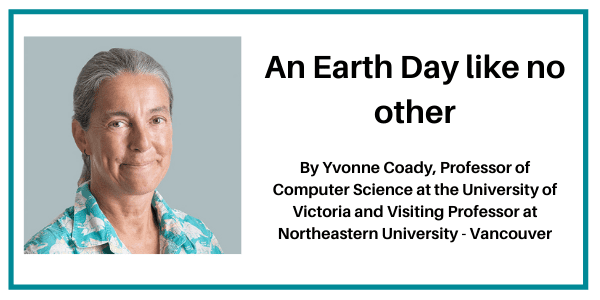We have all experienced the global pandemic over the past year and are united to emerge stronger than before from this epic crisis. There are no borders with COVID-19 and it has served as a stark reminder that we’re hanging on by a thread. This Earth Day is more important than ever because we really do need a global movement to take care of our planet and our long-term well-being. And while this may sound ominous, I’m filled with hope because I have the privilege of working with great students who are poised and ready to take on this challenge.
As a computer scientist, I see the extraordinary potential collecting and using new data to inform our policies, economic models and management of natural resources. Together, we can unlock data to support our planet. Every person and organization has a role to play in planning a better future for us all.
It starts with better understanding what’s going on within the complex web of relationships that we are all a part of, and digital technology can help. Using analytics, artificial intelligence, machine learning and other emerging innovations, and bringing together computer scientists and thought leaders from all walks of life, we can collaborate in new ways and ultimately save our planet. Through identifying meaningful data, we can offer a pathway to better understand and protect our ecosystems.
Case in point is the Earth Data Store, a Digital Technology Supercluster project that many of my students and I have been excited to be involved with. Our challenge is to work with large data sets, including massive amounts of satellite imagery. It’s almost like Mother Earth has taken a gigantic selfie and we have to figure out what she’s telling us. Fortunately, we have advanced technology, fantastic students and outstanding partners to clarify and extract value from earth observation data that can be used to help improve her, and our overall well-being.
What excites me most about Earth Data Store is the opportunity to use this platform to democratize access to these digital resources. This will also be an opportunity for people to integrate unique data sets, including collections from citizen scientists from everywhere around the world. Ultimately, it enables us to come together and do more to measure and manage our ecological impact. There’s tremendous long-term potential – everything from high school students contributing their field-trip research to up-and-coming innovators developing new and exciting applications that can run on this platform. They’re already envisioning mind-blowing applications with immersive interfaces such as augmented reality and virtual reality that help us compare our environment over time.
I recently moderated a panel discussion at a student event called Rewriting the 21st Century. As we reboot economies all over the world, we have a chance to revisit some of the tools and metrics used to guide policymakers, investors and businesses in decision-making. Our diverse panel debated the limitations of metrics such as GDP in terms of threats to our planet, and how alternatives such as doughnut economics could make a real difference in areas such as environmental monitoring and clean energy. An incredibly compelling report from BC’s Assembly of First Nations helped us all think about what a future wellness index could look like. We also talked about the kinds of careers and opportunities that align with these values, such as sustainability, and the important role of technology moving forward.
Let’s continue the conversation and collaboration. This truly is an ‘all-hands-on-deck’ effort!
